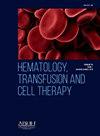预测镰状细胞病患儿急性胸部综合征发展的肺部超声波评分。
IF 1.6
Q3 HEMATOLOGY
引用次数: 0
摘要
研究目的本研究旨在确定入院时和 24-48 小时后与急性胸部综合征(ACS)相关的肺部超声波(LUS)检查结果,将这些结果与胸部X光检查(CXR)结果进行比较,并建立预测镰状细胞病(SCD)患儿肺部并发症发展的评分方法:一项前瞻性观察研究,研究对象为入院时和 24-48 小时后出现 ACS 体征或症状的 SCD 患儿,通过 LUS 和 CXR 进行评估。根据超声波检查结果设计了一个评分标准,用于预测住院期间 ACS 的演变情况:结果:78 名儿童接受了评估,其中 61 名(78.2%)患上了 ACS。入院时评分大于 1 分的患儿预测 ACS 的敏感性、特异性、准确性和阳性预测值(PPV)分别为 75.4%、88.2%、78.2% 和 95.8%,而只有 32 名患儿(52.5%)的 CXR 出现了变化。如果入院时的评分为零,则在住院期间发生 ACS 的可能性不大;如果评分大于 1,则发生 ACS 的可能性很大。在随访检查中,得分大于 1 的患者预测发生 ACS 的敏感性、特异性、准确性和 PPV 分别为 98.4%、76.5%、93.6% 和 92.8%。在随访中,得分为零的患者发生 ACS 的可能性很小,得分大于零的患者发生 ACS 的可能性很大:结论:LUS 是评估临床可疑 SCD 儿童发生 ACS 风险的有效工具。本文章由计算机程序翻译,如有差异,请以英文原文为准。
Lung ultrasound score to predict development of acute chest syndrome in children with sickle cell disease
Objective
This study aims to identify lung ultrasound (LUS) findings associated with acute chest syndrome (ACS) at the time of admission and 24–48 h later, to compare these to chest radiography (CXR) findings and to establish a score to predict the development of this pulmonary complication in sickle cell disease (SCD) children
Methods
A prospective observational study of SCD children presenting signs or symptoms of ACS evaluated by LUS and CXR at admission and 24–48 h later. A score was conceived to predict the evolution of ACS during hospitalization based on ultrasonographic findings.
Results
Seventy-eight children were evaluated; 61 (78.2 %) developed ACS. A score greater than one at admission showed sensitivity, specificity, accuracy, and positive predictive value (PPV) of 75.4 %, 88.2 %, 78.2 %, and 95.8 %, respectively to predict ACS, while only 32 (52.5 %) CXR showed alterations. The development of ACS during hospitalization was unlikely for a score of zero and very likely for a score greater than one at admission. Regarding follow-up exams, a score greater than one showed sensitivity, specificity, accuracy, and PPV of 98.4 %, 76.5 %, 93.6 %, and 92.8 %, respectively to predict the development of ACS. ACS development was very unlikely for a score of zero and very likely for a score greater than zero in the follow-up.
Conclusion
LUS is an effective tool to assess risk for the development of ACS in SCD children with clinical suspicion.
求助全文
通过发布文献求助,成功后即可免费获取论文全文。
去求助
来源期刊

Hematology, Transfusion and Cell Therapy
Multiple-
CiteScore
2.40
自引率
4.80%
发文量
1419
审稿时长
30 weeks
 求助内容:
求助内容: 应助结果提醒方式:
应助结果提醒方式:


